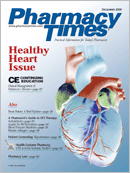Publication
Article
Pharmacy Times
A Pharmacist's Guide to OTC Therapy: Rhinitis (Allergic)
Author(s):
Allergic rhinitis is a systemic condition that is characterized by sneezing, nasal itching and irritation, runny nose, congestion; red, watery eyes; headache; and impaired sense of smell. Complications of chronic allergic rhinitis include sinusitis, otitis media, nasal polyps, and upper respiratory tract infections. Because asthma and allergies often can coexist, people with an allergy are more likely to develop asthma. Allergic rhinitis also can worsen symptoms in people who already have asthma.1 Although allergic rhinitis is not always considered a serious medical condition, the severity of symptoms can significantly impact an individual's quality of life.
Triggers
Allergic rhinitis typically occurs when an individual comes into contact with an allergen, such as pollen, cleaning products, cosmetics, cigarette smoke, dust mites, pet dander, or mold spores. Inflammation occurs in the mucous membranes of the nasal cavity, the eyes, the eustachian tubes, the middle ear, the sinuses, and/or the pharynx.2
Nonprescription Treatments
Antihistamines
Antihistamines are the first choice of treatment for many patients for the relief of rhinorrhea, itching, and sneezing. These products exert their pharmacologic effects by competing with histamine at central and peripheral histamine 1-receptor sites, thus preventing histamine-receptor interaction and subsequent mediator release.3 The use of antihistamines is contraindicated in patients using monoamine oxidase inhibitors and those with narrow-angle glaucoma, stenosing peptic ulcer, prostatic hypertrophy, bladder neck obstruction, and pyloroduodenal obstruction.3
First-generation antihistamines are sedating, and second-generation antihistamines are nonsedating (Table). Loratadine is the only nonsedating antihistamine available as an OTC agent.3 It does not have anticholinergic activity and penetrates poorly into the central nervous system (CNS).
Decongestants
Because pseudoephedrine has been widely used in the illegal preparation of methamphetamine, products containing pseudoephedrine are now dispensed from behind the counter. Many manufacturers also have produced new formulations of some of their products to contain phenylephrine instead of pseudoephedrine.
The use of decongestant sprays for more than 3 days consecutively can result in "rebound" congestion. Common adverse effects of systemic decongestants include CNS effects, such as feelings of restlessness and insomnia; and cardiovascular effects, such as elevated blood pressure and tachycardia. The use of decongestants also may exacerbate hypertension, hyperthyroidism, prostatic hypertrophy, and diabetes mellitus, as well as other conditions.
Cromolyn Sodium
Whereas the exact mechanism of action of cromolyn sodium is unknown, it stabilizes mast cells, thus preventing mediator release.3 It does not stop inflammation that has begun. The drug should be started before the allergy season starts and used daily during the season. There are few side effects, although some people get nasal stinging or burning.4 Common adverse effects include headache and nasal irritation or burning.
The Role of the Pharmacist
Pharmacists can play a vital role in ensuring that patients make proper product selections. Pharmacists should carefully assess preexisting medical conditions to screen for potential contraindications, review concurrent medication profiles to prevent potential drug interactions, and ascertain any history of allergic reactions to certain agents. Pharmacists also should educate patients thoroughly on adverse effects and encourage patients to seek medical care from a physician.
Ms. Terrie is a clinical pharmacy writer based in the northern Virginia area.
For a list of references, send a stamped, self-addressed envelope to: References Department, Attn. A. Stahl, Pharmacy Times, 241 Forsgate Drive, Jamesburg, NJ 08831; or send an e-mail request to: astahl@ascendmedia.com.







